engine Citroen C4 AIRCROSS RHD 2017 1.G Repair Manual
[x] Cancel search | Manufacturer: CITROEN, Model Year: 2017, Model line: C4 AIRCROSS RHD, Model: Citroen C4 AIRCROSS RHD 2017 1.GPages: 368, PDF Size: 11.44 MB
Page 188 of 368
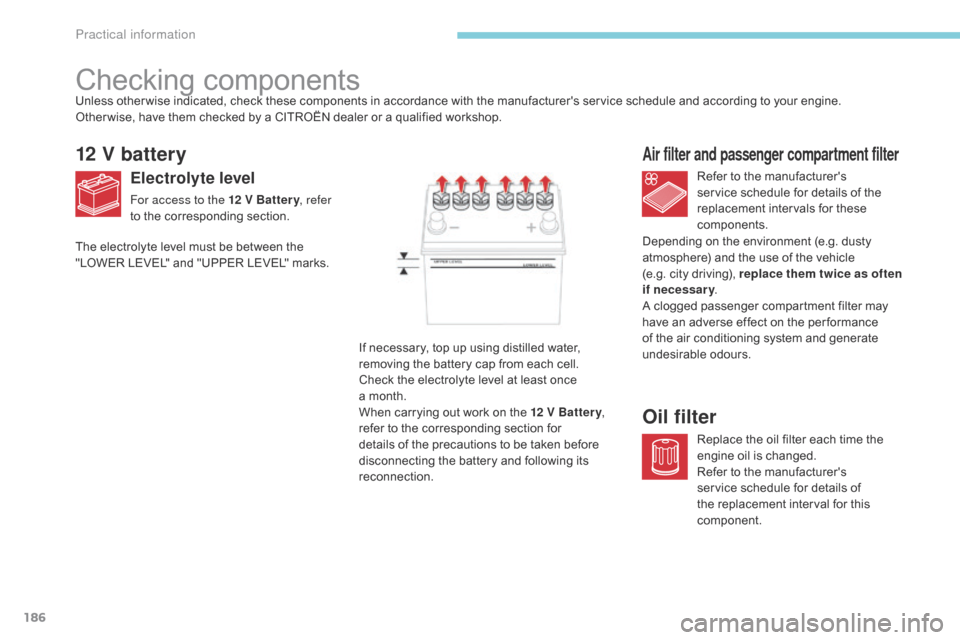
186
Checking components
12 V battery
Electrolyte level
For access to the 12 V Battery, refer
to the corresponding section. Refer to the manufacturer's
service schedule for details of the
replacement intervals for these
components.
Air filter and passenger compartment filter
Replace the oil filter each time the
engine oil is changed.
Refer to the manufacturer's
service schedule for details of
the replacement interval for this
component.
Oil filter
If necessary, top up using distilled water,
removing the battery cap from each cell.
Check the electrolyte level at least once
a
month.
When carrying out work on the 12 V Battery,
refer to the corresponding section for
details of the precautions to be taken before
disconnecting the battery and following its
reconnection.
Unless other wise indicated, check these components in accordance with the manufacturer's service schedule and according to your engine.
Other wise, have them checked by a CITROËN dealer or a qualified workshop.
The electrolyte level must be between the
"LOWER LEVEL" and "UPPER LEVEL" marks.
Depending on the environment (e.g. dusty
atmosphere) and the use of the vehicle
(e.g. city driving), replace them twice as often
if necessary
.
A clogged passenger compartment filter may
have an adverse effect on the per formance
of the air conditioning system and generate
undesirable odours.
Practical information
Page 189 of 368
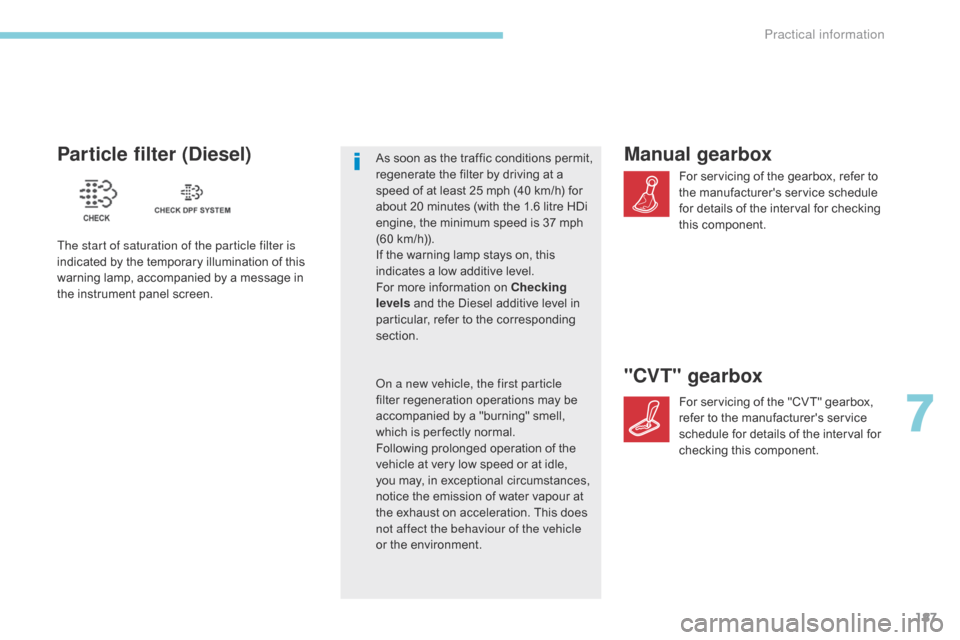
187
Manual gearbox
For servicing of the gearbox, refer to
the manufacturer's service schedule
for details of the interval for checking
this component.
"CVT" gearbox
For servicing of the "CVT" gearbox,
refer to the manufacturer's service
schedule for details of the interval for
checking this component.
Particle filter (Diesel)
The start of saturation of the particle filter is
indicated by the temporary illumination of this
warning lamp, accompanied by a message in
the instrument panel screen.As soon as the traffic conditions permit,
regenerate the filter by driving at a
speed of at least 25 mph (40 km/h) for
about 20 minutes (with the 1.6 litre HDi
engine, the minimum speed is 37 mph
(60 km/h)).
If the warning lamp stays on, this
indicates a low additive level.
For more information on Checking
levels
and the Diesel additive level in
particular, refer to the corresponding
section.
On a new vehicle, the first particle
filter regeneration operations may be
accompanied by a "burning" smell,
which is per fectly normal.
Following prolonged operation of the
vehicle at very low speed or at idle,
you may, in exceptional circumstances,
notice the emission of water vapour at
the exhaust on acceleration. This does
not affect the behaviour of the vehicle
or the environment.
7
Practical information
Page 207 of 368
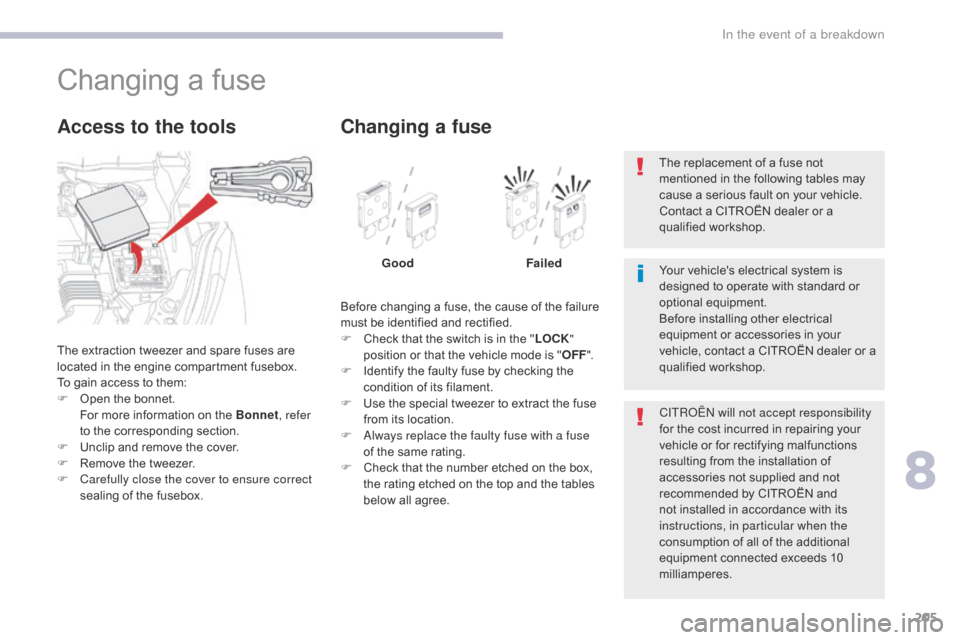
205
Changing a fuse
The extraction tweezer and spare fuses are
located in the engine compartment fusebox.
To gain access to them:
F
O
pen the bonnet.
F
or more information on the Bonnet , refer
to the corresponding section.
F
U
nclip and remove the cover.
F
R
emove the tweezer.
F
C
arefully close the cover to ensure correct
sealing of the fusebox.
Access to the tools
Before changing a fuse, the cause of the failure
must be identified and rectified.
F
C
heck that the switch is in the " LOCK"
position or that the vehicle mode is " OFF".
F
I
dentify the faulty fuse by checking the
condition of its filament.
F
U
se the special tweezer to extract the fuse
from its location.
F
A
lways replace the faulty fuse with a fuse
of the same rating.
F
C
heck that the number etched on the box,
the rating etched on the top and the tables
below all agree.
Changing a fuse
Good Failed
CITROËN will not accept responsibility
for the cost incurred in repairing your
vehicle or for rectifying malfunctions
resulting from the installation of
accessories not supplied and not
recommended by CITROËN and
not installed in accordance with its
instructions, in particular when the
consumption of all of the additional
equipment connected exceeds 10
milliamperes. Your vehicle's electrical system is
designed to operate with standard or
optional equipment.
Before installing other electrical
equipment or accessories in your
vehicle, contact a CITROËN dealer or a
qualified workshop. The replacement of a fuse not
mentioned in the following tables may
cause a serious fault on your vehicle.
Contact a CITROËN dealer or a
qualified workshop.
8
In the event of a breakdown
Page 210 of 368
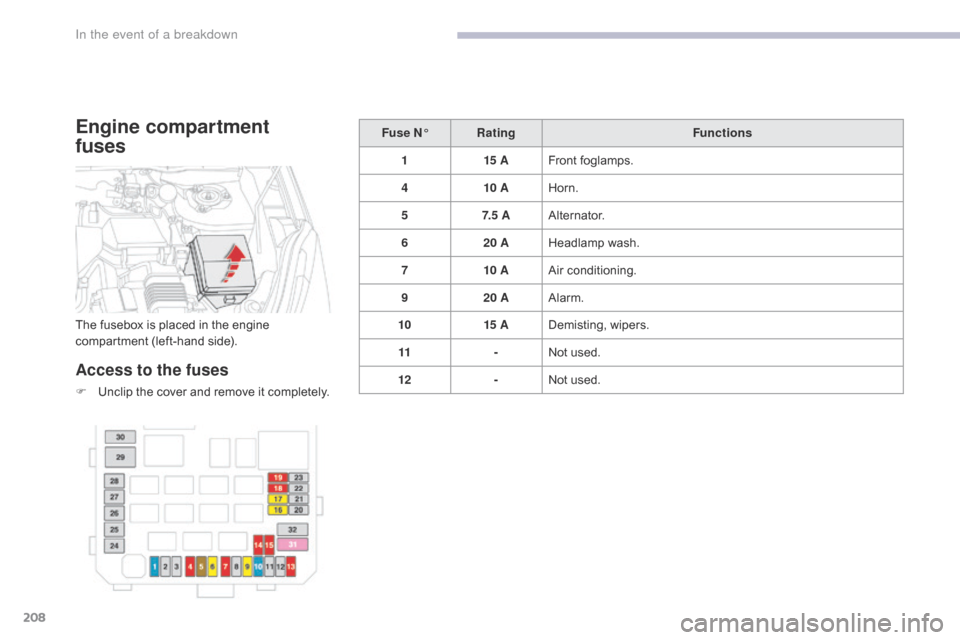
208
Engine compartment
fuses
Access to the fuses
F Unclip the cover and remove it completely.Fuse N°
Rating Functions
1 15 AFront foglamps.
4 10 AHorn.
5 7. 5 AAlternator.
6 20 AHeadlamp wash.
7 10 AAir conditioning.
9 20 AAlarm.
10 15 ADemisting, wipers.
11 -Not used.
12 -Not used.
The fusebox is placed in the engine
compartment (left-hand side).
In the event of a breakdown
Page 212 of 368
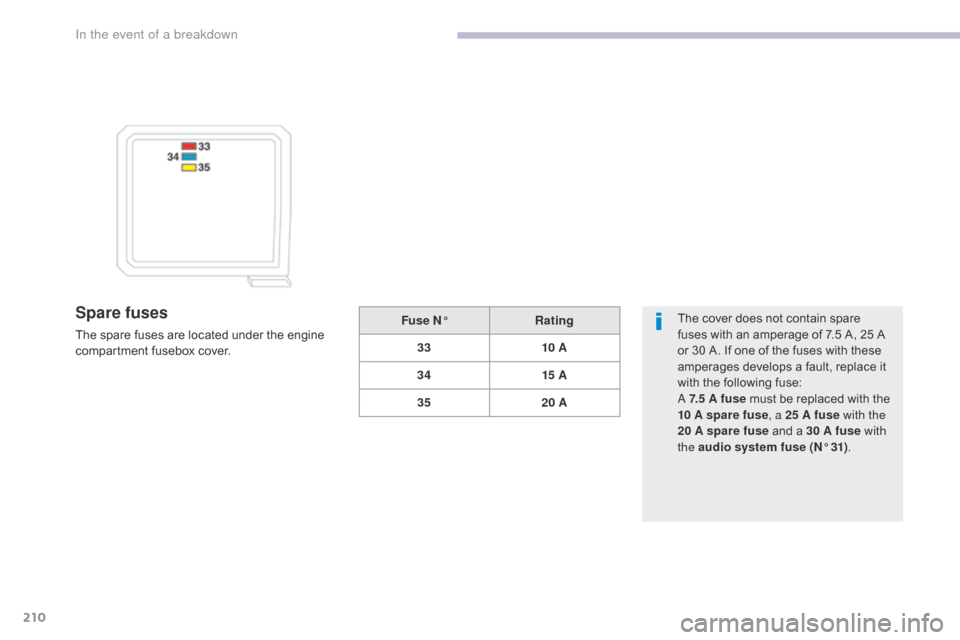
210
Spare fuses
The spare fuses are located under the engine
compartment fusebox cover.The cover does not contain spare
fuses with an amperage of 7.5 A, 25 A
or 30 A. If one of the fuses with these
amperages develops a fault, replace it
with the following fuse:
A 7.5 A fuse must be replaced with the
10 A spare fuse
, a 25 A fuse with the
20 A spare fuse and a 30 A fuse with
the audio system fuse (N° 31) .
Fuse N°
Rating
33 10 A
34 15 A
35 20 A
In the event of a breakdown
Page 213 of 368
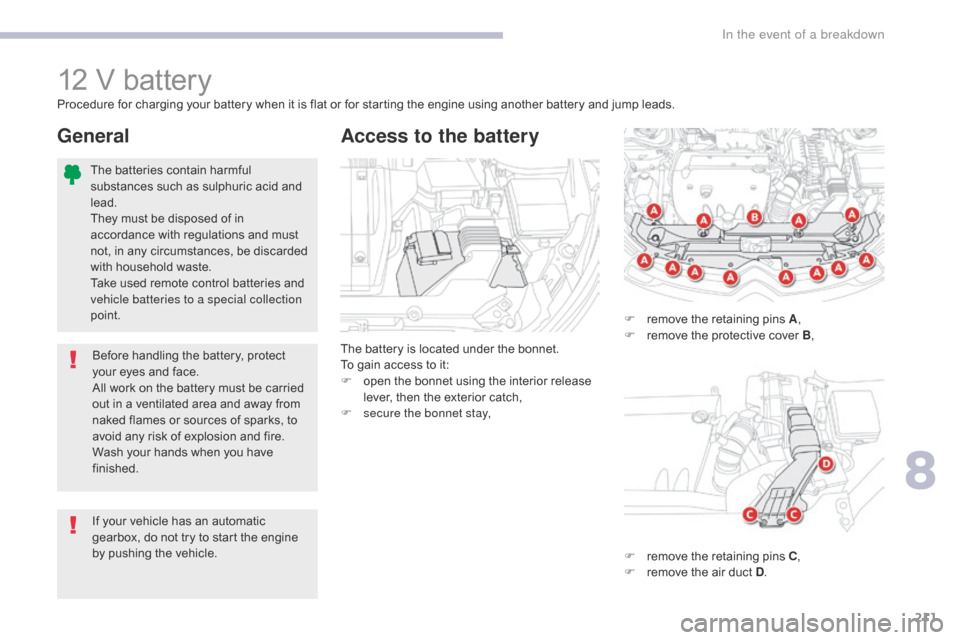
211
12 V battery
The battery is located under the bonnet.
To gain access to it:
F
o
pen the bonnet using the interior release
lever, then the exterior catch,
F
s
ecure the bonnet stay,
Access to the battery
Procedure for charging your battery when it is flat or for starting the engine using another battery and jump leads.
F
r
emove the retaining pins A,
F
r
emove the protective cover B,
F
r
emove the retaining pins C,
F
r
emove the air duct D.
General
If your vehicle has an automatic
gearbox, do not try to start the engine
by pushing the vehicle.
The batteries contain harmful
substances such as sulphuric acid and
lead.
They must be disposed of in
accordance with regulations and must
not, in any circumstances, be discarded
with household waste.
Take used remote control batteries and
vehicle batteries to a special collection
point.
Before handling the battery, protect
your eyes and face.
All work on the battery must be carried
out in a ventilated area and away from
naked flames or sources of sparks, to
avoid any risk of explosion and fire.
Wash your hands when you have
finished.
8
In the event of a breakdown
Page 214 of 368

212
Check the electrolyte level and top up if
necessary.
For more information on Checking levels,
refer to the corresponding section.
Starting using another
battery
F Connect the red cable to the (+) terminal of the flat battery A , then to the (+) terminal of
the slave battery B . F
C onnect one end of the green or black
cable to the (-) terminal of the slave
battery
B.
F
C
onnect the other end of the green or black
cable to the earth point C on your vehicle
(engine mounting).
F
O
perate the starter, let the engine run.
F
W
ait until the engine returns to idle and
disconnect the cables.
F
R
aise the protective cover on
the (+) terminal.
Some functions, including Stop & Start,
are not available if the battery is not
sufficiently charged.
In the event of a breakdown
Page 215 of 368
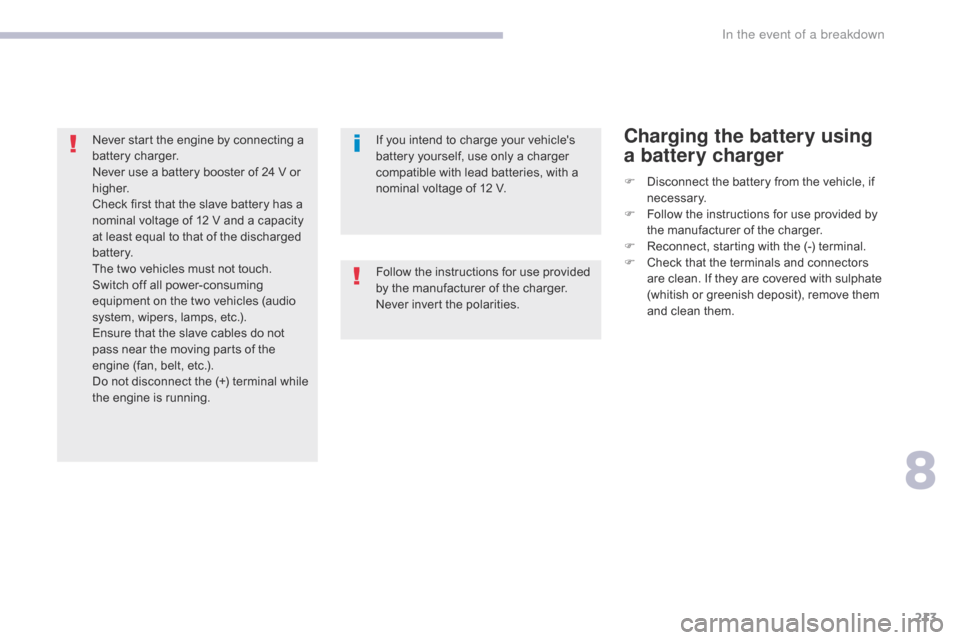
213
If you intend to charge your vehicle's
battery yourself, use only a charger
compatible with lead batteries, with a
nominal voltage of 12 V.F
D
isconnect the battery from the vehicle, if
necessary.
F
F
ollow the instructions for use provided by
the manufacturer of the charger.
F
R
econnect, starting with the (-) terminal.
F
C
heck that the terminals and connectors
are clean. If they are covered with sulphate
(whitish or greenish deposit), remove them
and clean them.Charging the battery using
a battery charger
Follow the instructions for use provided
by the manufacturer of the charger.
Never invert the polarities.
Never start the engine by connecting a
battery charger.
Never use a battery booster of 24 V or
higher.
Check first that the slave battery has a
nominal voltage of 12 V and a capacity
at least equal to that of the discharged
battery.
The two vehicles must not touch.
Switch off all power-consuming
equipment on the two vehicles (audio
system, wipers, lamps, etc.).
Ensure that the slave cables do not
pass near the moving parts of the
engine (fan, belt, etc.).
Do not disconnect the (+) terminal while
the engine is running.
8
In the event of a breakdown
Page 216 of 368

214
Do not invert the polarities and use only a 12 V charger.
Do not disconnect the terminals while the engine is running.
Do not charge the batteries without disconnecting the terminals first.
Do not push the vehicle to start the engine if it is fitted with a CVT gearbox.
Disconnecting the battery
To maintain a sufficient level of charge
to start the engine, it is advisable to
disconnect the battery if the vehicle is not
going to be used for a very long period.
Before disconnecting the battery:
F
C
lose all the doors and windows,
the
tailgate and the roof.
F
S
witch off all power-consuming
equipment (audio system, wipers,
lamps, etc.).
F
S
witch off the ignition and wait
4
m
inutes.
Once you have gained access to
the
battery, start by disconnecting
the (-) terminal.
Following reconnection of the
battery
Following reconnection of the battery,
switch on the ignition and wait 1 minute
before starting to permit initialisation of the
electronic systems.
However, if problems remain following this
operation, contact a CITROËN dealer or a
qualified workshop.
Referring to the corresponding section, you
must reinitialise certain equipment yourself,
such as:
-
T
he remote control key or the electronic
key (depending on version).
-
T
he electric blind(s).
-
T
he electric windows.
-
T
he date and time.
-
T
he stored radio stations. Some functions, including Stop & Start,
are not available if the battery is not
sufficiently charged.
Never try to charge a frozen battery.
If the battery has been frozen, have
it checked by a CITROËN dealer or a
qualified workshop, who will check that
the internal components have not been
damaged and the casing is not cracked,
which could cause a leak of toxic and
corrosive acid.
The Stop & Start system may not be
operational during the trip following the
first engine start.
In this case, the system will only be
available again after a continuous
period of immobilisation of the vehicle,
a period which depends on the exterior
temperature and the state of charge of
the battery (up to about 8 hours).
In the event of a breakdown
Page 217 of 368
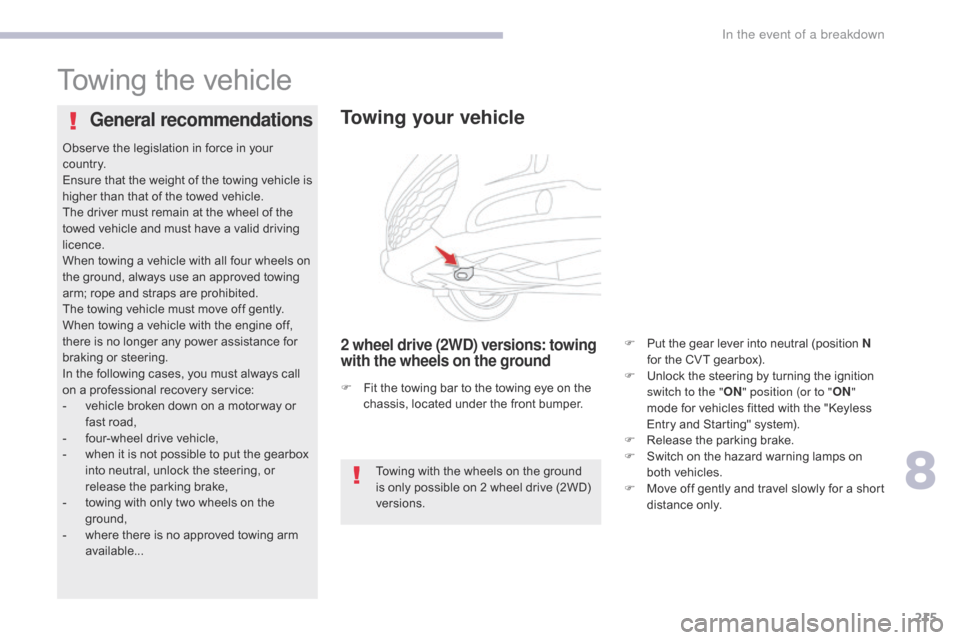
215
Towing the vehicle
Towing your vehicle
2 wheel drive (2WD) versions: towing
with the wheels on the ground
General recommendations
Towing with the wheels on the ground
is only possible on 2 wheel drive (2WD)
versions.
F
F
it the towing bar to the towing eye on the
chassis, located under the front bumper.
Observe the legislation in force in your
c o unt r y.
Ensure that the weight of the towing vehicle is
higher than that of the towed vehicle.
The driver must remain at the wheel of the
towed vehicle and must have a valid driving
licence.
When towing a vehicle with all four wheels on
the ground, always use an approved towing
arm; rope and straps are prohibited.
The towing vehicle must move off gently.
When towing a vehicle with the engine off,
there is no longer any power assistance for
braking or steering.
In the following cases, you must always call
on a professional recovery service:
-
v
ehicle broken down on a motor way or
fast road,
-
f
our-wheel drive vehicle,
-
w
hen it is not possible to put the gearbox
into neutral, unlock the steering, or
release the parking brake,
-
t
owing with only two wheels on the
ground,
-
w
here there is no approved towing arm
available... F
P
ut the gear lever into neutral (position N
for the CVT gearbox).
F
U
nlock the steering by turning the ignition
switch to the " ON" position (or to " ON"
mode for vehicles fitted with the "Keyless
Entry and Starting" system).
F
R
elease the parking brake.
F S witch on the hazard warning lamps on
both vehicles.
F
M
ove off gently and travel slowly for a short
distance only.
8
In the event of a breakdown